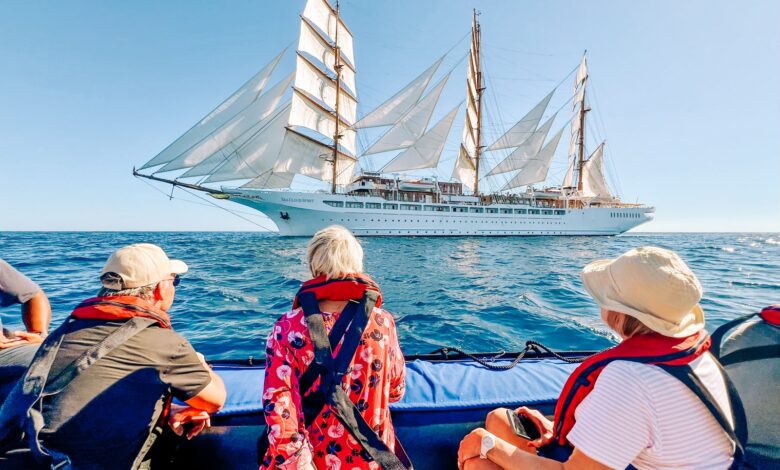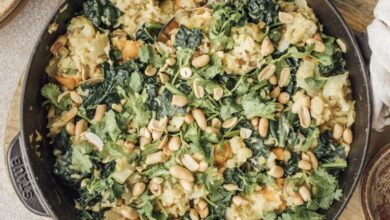Why this new sailing ship may be the ultimate way to explore Costa Rica and Panama

Just a handful of passengers are awake as our giant three-masted sailing ship, Sea Cloud Spirit, chases the sunrise into Costa Rica’s remote Golfo Dulce — one of the most eco-diverse bays on the planet. But for those early risers, it’s a treat.
From the soaring, 136-passenger vessel’s teak-lined top deck, we watch as the rising sun lights up the fjord-like bay’s pristine and primeval shoreline — a verdant patchwork of palm-lined beaches, dense mangroves and twisty rivers.
It is a prelude to a day of adventure. After the ship anchors early off the tiny coastal town of Puerto Jimenez, we are soon zipping to shore in a tender boat to spread out in search of wildlife.
For more cruise guides, news and tips, sign up for TPG’s cruise newsletter.
Some of us head off on a nature walk to a crocodile-filled lagoon. Others board a catamaran searching for dolphins. Still others, like me, ride a van into the rainforest looking for the elusive sloths that call this region home.
At the recently opened La Perica Sloth Garden, we find them in droves, along with capuchin monkeys, scarlet macaws and other iconic denizens of the Costa Rica jungle.
It is, in short, a classic day of exploring the Golfo Dulce region and the wildlife-rich Osa Peninsula that makes up its north shore.
It’s also wonderfully different from the outdoorsy experiences we had just the day before in and around Costa Rica’s more northerly Manuel Antonio National Park and what we will see tomorrow as we head south to the 39 islands and islets that make up Panama’s Coiba National Park.
On this 11-night Sea Cloud Spirit sailing down the coasts of Costa Rica and Panama, just about every day brings a new adventure, including — on many days — the experience of traveling under the power of nothing but the wind.

Daily Newsletter
Reward your inbox with the TPG Daily newsletter
Join over 700,000 readers for breaking news, in-depth guides and exclusive deals from TPG’s experts
1 of 6
A guide at Costa Rica’s La Perica Sloth Garden offers an introduction to the slow-moving animals. GENE SLOAN/THE POINTS GUY
In addition to wildlife and nature experiences, there’s also a daylight crossing of the Panama Canal — a chance to see one of the great marvels of human engineering up close.
The final day of the trip includes a visit with the indigenous Kuna people living in the remote San Blas Islands just off the coast of Panama.
It’s the sort of diversity of experiences that is hard to arrange during a land-based trip to Costa Rica and Panama unless you have far more time than 11 days.
Propelled by the power of the wind
Sea Cloud Spirit, which Germany-based Sea Cloud Cruises unveiled in 2021, isn’t the first cruise vessel to offer voyages focused on the coasts of Costa Rica and Panama. Small vessels operated by Windstar Cruises, Lindblad Expeditions, Ponant and Aurora Expeditions also offer such trips.
Still, Sea Cloud Spirit may be the most intriguing ship to ply the route. Five decks high and nearly 500 feet long, it is a full-rigged, three-masted sailing vessel of the sort that hasn’t been common on the world’s oceans for more than a century.
As large sailing ships go, it’s also particularly authentic in how it operates.
Related: Why Sea Cloud Spirit is a vessel you’ll want to try
Sea Cloud Spirit is, notably, propelled by a massive, old-style array of 28 sails that are unfurled by hand by an enormous team of 19 deckhands — something you don’t see on almost any other large sailing ship in the world.
Most other large sailing ships offering multiday cruises, such as the two sailing vessels Windstar Cruises sometimes deploys to Costa Rica and Panama (Wind Star and Wind Spirit), have automated sails that unfurl at the push of a button.
1 of 6
Sea Cloud Spirit anchored in Costa Rica’s Golfo Dulce. GENE SLOAN/THE POINTS GUY
The result is a much different experience of coastal travel on Sea Cloud Spirit from the one you’ll get from any other ship.
In addition to being sailed by hand, another differentiator for Sea Cloud Spirit when sailing the Costa Rica and Panama coasts is that it offers a more expansive exploration of the region than you’ll generally get with other ships. Most of the small-ship cruise itineraries in the region are seven nights in length. Sea Cloud Cruises, by contrast, typically budgets 10 to 11 nights for Sea Cloud Spirit to cover the same territory.
Even under full sails, the vessel often only meanders down the coast at just three to five knots.
Call it the “slow travel” way to do the Costa Rica and Panama coasts.
Exploring the Pacific side of Costa Rica
Our sailing down the coasts of Costa Rica and Panama begins in the sleepy Costa Rica port town of Puntarenas, on the Pacific side of the country. But we don’t stay there long.
Just hours after passengers arrive at the ship, which is tied up all alone at an otherwise empty dock, Sea Cloud Spirit sets off on a six-day exploration of Costa Rica’s Pacific coast — a region known for ecotourism of all sorts, from spotting monkeys and colorful birds in national parks to zip lining through lush rainforests and horseback riding along unspoiled beaches.
After rounding Costa Rica’s famous-for-its-surfing Nicoya Peninsula, Sea Cloud Spirit points northward toward the northwesternmost corner of the country near the border with Nicaragua.
It is here, after a day of cruising under full sails, driven by the power of the wind alone, that we land at Playa Panama — a secluded and quiet crescent of dark sand beach that serves as a gateway to nearby Palo Verde National Park.
After motoring to shore in Zodiac boats, many of the ship’s passengers head to the national park for a boat ride through its marshlands in search of monkeys and crocodiles, as well as the many colorful birds for which it is known. Others visit a hacienda for horseback riding with the local cowboys and zip lining through the surrounding forests.
Related: The 18 best small cruise ships in the world
A handful of us, including me, sign on for a catamaran ride along the rocky coastline to a reef for snorkeling with colorful fish, margaritas on deck and spectacular sunset views over the ocean on the way back.
It is the sort of diverse outdoorsy pursuits that a vacationer could experience while staying at one of the area’s resorts, such as the Four Seasons we passed on our way to our snorkeling site.
But unlike those land-based visitors, we would see a much wider array of Costa Rica’s allures over the coming days.
Heading south from Playa Panama, we spend another full day cruising along the Costa Rica coast under full sails before reaching Quepos, the gateway to another of Costa Rica’s iconic eco-destinations: Manuel Antonio National Park.
Outings to the national park and other private reserves in the area are the order of the day here after we land by tender boat at the small dock in Quepos.
Not wanting to rise at the crack of dawn, as is required for the Manuel Antonio National Park tour, I instead choose an afternoon hike over swinging bridges and past tumbling waterfalls at a small rainforest preserve called Rainmaker Conservation Park.
1 of 6
Sea Cloud Spirit passengers cross swinging bridges at the Rainmaker Conservation Park in Costa Rica. GENE SLOAN/THE POINTS GUY
It turns into a perfect day, partly because I sneak away from the tour group with one other tour member (with the guide’s permission) to climb a too-steep-for-most trail to a spectacular series of hanging bridges. We have it all to ourselves.
The next day Sea Cloud Spirit brings us to Costa Rica’s Golfo Dolce, mentioned above.
With the stops at Playa Panama, Quepos and the Golfo Dulce’s Puerto Jimenez, we have visited all three major segments of the Pacific coast of Costa Rica — the north, middle and south — in just a few days.
While we only make short day stops in each area, it’s a taste of the country that isn’t available to the typical visitor who comes to Costa Rica for a week and stays in one location.
Off-the-beaten-path Panama
After six days along Costa Rica’s Pacific coast, Sea Cloud Spirit drives southward into the waters off Panama, where our first stop is the cluster of 39 islands and islets that make up Panama’s Coiba National Park.
Designated a UNESCO World Heritage Site, the mostly uninhabited island group is known for its untouched rainforests and wildlife that exists nowhere else, such as the Coiba Island howler monkey. But for our purposes, it serves mostly as a place to stop for a beach day as we land by Zodiac at one of its many sandy beaches for snorkeling and sunning.
Unlike many of my Sea Cloud Spirit compatriots, I skip the snorkeling, scared away by a warning in the ship’s daily planner about the occasional presence of plankton and jellyfish in the water that send out “stinging microscopic harpoons.” But I find diversion in a small one-room national park visitors center just off the beach that goes into great depth on its flora and fauna.
It is here that I learned that the particular island where we landed, the island cluster’s main island of Coiba, once served as a penal colony known for brutal conditions and the disappearance of political prisoners during the dictatorships of Panamanian strongmen Omar Torrijos and Manuel Noriega.
1 of 4
Sea Cloud Spirit passengers spend a day snorkeling and sunning at Coiba Island, part of Panama’s Coiba National Park. GENE SLOAN/THE POINTS GUY
Two days later, after another full day of sailing down the coast, we get a second beach day with snorkeling at Mogo Mogo Island, part of another cluster of islands and islets off the Panama coast called the Pearl Islands.
Here, I brave the plankton and jellyfish stings to wade out past the rocky shallows to snorkel the edge of a coral reef teeming with foureye butterflyfish and honeycomb trunkfish.
Not only is the water crystal clear and the fish lovely, but it is an outing that I survive without a single strike from a stinging harpoon (several of my snorkeling companions, alas, do report such strikes, though they say it’s not terribly painful).
The marvel of the Panama Canal
The next day of the trip brings an adventure of a different sort as Sea Cloud Spirit transits through the Panama Canal.
Passengers line the teak walkway in front of Sea Cloud Spirit’s bridge early in the morning to watch as the vessel glides through Balboa Harbor near Panama City to the start of the canal at the Miraflores Locks.
It is the first of three sets of giant rectangular chambers that will lift the 4,228-gross-ton vessel up and over the Continental Divide to the Caribbean, and it is a sight to behold.
After we enter the first of the chambers, seven-story-high steel gates slowly swing shut behind us, and the basin begins filling with millions of gallons of water. At 1,050 feet long, the lock is roughly the size of three football fields — so long that a second cruise vessel, the 100-passenger Emerald Azzurra, fits into the chamber behind us.
More than 100 years after its construction by the United States, the 48-mile-long Panama Canal remains a marvel of modern engineering — and an alluring attraction for cruisers on trips to the region.
As passengers learn during an onboard lecture the day before our transit, thousands of workers toiled for a decade to carve the passageway out of the dense Panamanian jungle. In addition to building giant locks at both sides of the canal (near both the Pacific and Atlantic entrances), its builders had to construct what at the time was the world’s largest dam along the Chagres River, which in turn created one of the world’s largest man-made lakes.
Dubbed Gatun Lake, the 21-mile-long body of water makes up a significant part of the waterway vessels use to cross the country.
Sea Cloud Spirit spends much of the day crossing the canal from the Pacific to the Atlantic as the ship’s onboard lecturer, Stephen Weston, offers a running narrative from the top deck.
The entire process of moving between the Pacific and Atlantic oceans takes just seven hours.
The indigenous people of San Blas
The final stop on this trip is the San Blas Islands, a sprinkling of several hundred mostly uninhabited spits of white sand and palm trees that rest off Panama’s Caribbean coast.
Controlled by the Kuna, an indigenous people spread across three politically autonomous reservations in Panama and Colombia, the islands are mostly off-limits to tourists and undeveloped for mass tourism, as the Kuna like it. But the Kuna allow small groups of visitors, such as those aboard Sea Cloud Spirit, to visit occasionally.
Anchoring off the Kuna-inhabited island of Wichub Wala, we tender to a small dock to wander the sandy paths between the Kuna’s bamboo and palm leaf huts, past the dugout canoes they use for fishing.
1 of 6
Sea Cloud Spirit naturalist Stephen Weston discusses the locally made molas with a resident of the Kuna island of Wichub Wala. GENE SLOAN/THE POINTS GUY
It is, for many passengers, an opportunity to purchase a souvenir from the trip that is hand-made and local, as the women of the village line the pathways hawking the colorful needlework panels called molas that they make both for their own use (traditionally, they sew them onto the fronts of their blouses) and for tourists.
Molas that we’re told take weeks to make sell for about $15 to $20.
The brief visit to Wichub Wala also includes a short dance performance by the Kuna in their main square before we are back on the tender to the ship. It is a morning stop paired with an afternoon call at another sandy island for more snorkeling and swimming.
The trip ends the next morning in Colon on Panama’s Caribbean coast.
Bottom line
A voyage along the Pacific coast of Costa Rica and Panama on Sea Cloud Spirit is an intriguing way to see the highlights of both countries in a single trip.
One of the biggest passenger sailing ships ever built, Sea Cloud Spirit takes a go-slow approach to travel down the coast from Puntarenas, Costa Rica, to the Pearl Islands of Panama, followed by a daylight crossing of the Panama Canal to the Caribbean side of Panama. Along the way, it visits several of the most popular tourist areas in the two countries and offers passengers a relatively rare opportunity to experience the joys of sailing the region on a tall ship.
One caveat about the trips: Sea Cloud Cruises, which is based in Hamburg, Germany, has a big following in Germany, and its Sea Cloud Spirit sailings often are heavy with German speakers. That said, the vessel’s onboard program is bilingual (the relatively rare number of announcements on board are made in German and English, and most of the staff speaks both languages). You’ll likely find at least some English speakers among your fellow passengers.
For more details on what it’s like on board, see TPG’s first-look guide to Sea Cloud Spirit.
Ten-night Sea Cloud Spirit sailings to Costa Rica and Panama start at $9,530 per person, based on double occupancy. For more information, call 888-732-2568 or visit seacloud.com.
Planning a cruise? Start with these stories:




